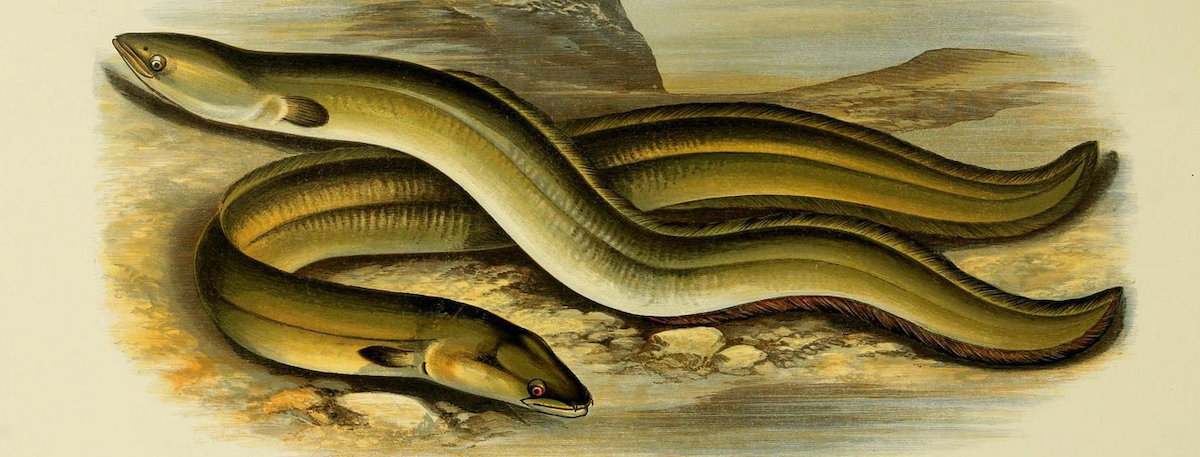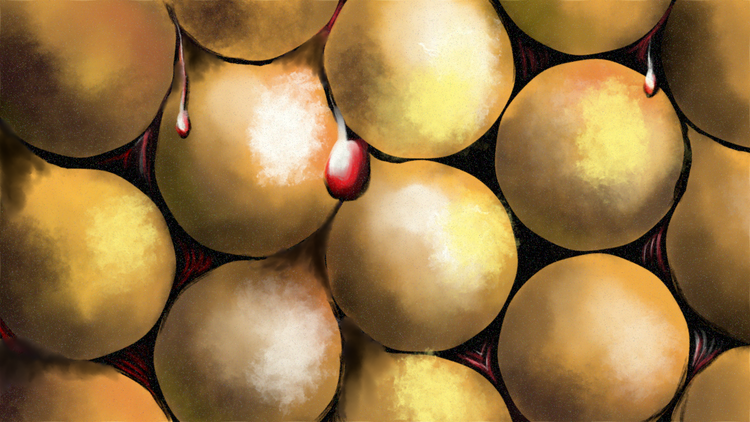
Book Review | The Book of Eels & Eels: An Exploration
The Book of Eels was written (in Swedish) by first-time author Patrik Svensson, and translated into English by Agnes Broome. It is about the European eel, and its chapters alternate between natural history and memoir of Svensson's youth spent eel-catching with his father. Eels: an Investigation is by James Prosek, a Connecticut-born writer whose earlier works mostly concern trout. It covers freshwater eels from around the world: American eels in the northeastern U.S., longfin eels in New Zealand, Japanese eels in the Tsukiji fish market, and tropical eels in Micronesia; no real attention is paid in Prosek's book to the European eel. The two books, when read back-to-back as I have done, thus complement each other well. not only does Svensson's book deal with the eel that Prosek's doesn't, it also gives a deeper look at eel research. Prosek, in turn, gives a deeper look into the current state of the world's eels. Svensson's experiences with eels add a personal touch to his book.
Analysis
The two books, though similar in their subjects, are different in their approaches. Svensson's has two narratives: the story of the search for the spawning grounds of the European eel, and his story of eel-fishing in the Swedish coast region. Prosek tells a different story in each chapter. Both books are largely human histories of the eel; eels themselves can be described, as well as we understand them, rather quickly:
Eels begin their lives as tiny, transparent, flat creatures that drift in the ocean, eating small bits of "marine snow" (flakes of dead tissue shed by aquatic carcasses) and riding currents toward the land. As they gather near shores and begin to enter the mouths of rivers, they become "glass eels", still small and see-through but eel-shaped and able to swim under their own power. Glass eels mature into typical eels: predatory fish who prefer dark, murky waters, but who are known to slither out onto land if given cause. After some time, in response to an unknown trigger, the eels enter their final life stage; their digestive system is re-absorbed and converted into reproductive organs, and the eels return to the sea, travelling to their spawning grounds, somehow producing eel larvae, and then dying. Only in the North Pacific spawning grounds of the Japanese and mottled eels have adult eels been found, and no eel's actual spawning has ever been observed.

Describing humanity's relationship with eels takes more words, enough to fill the better parts of two books, at least. The chief thing that people do with eels is eat them. Svensson's stories of fishing for eels with his father end with him eating eel with his father; he writes that he himself didn't like eel, but that his father loved it. Prosek, in his remarks of acknowledgement at the end of his book, says that he originally envisioned his work as a sort of cookbook collecting eel recipes from around the world.
There are, of course, many people who do not eat eel, for various reasons: many people just aren't in the habit, or find eels disgusting when alive and probably imagine them no better when dead and cooked. Some hold eels to be religiously unclean. One people, the Laisalap of Micronesia, think too much of eels to eat them:
"I like the taste of dog most of all," she said, raising and then lowering her eyebrows in succession—the Pohnpeian manner of indicating the affirmative (as opposed to nodding the head). "More than pigs," she added gleefully. "They are really good. We raise dogs as pets, but we usually don’t eat our own dogs. We eat our neighbors’ dogs." She laughed again. "If a dog ever bites someone or hurts someone, we eat it."
"Would you ever eat eel?" I asked.
"Never!" she said, shocked at the mere suggestion, laughing at me.
The people who do eat eels tend to be people at the margins of society: starving settlers, rural holdouts, indigenous groups, of simply the poor and desperate. Japan is the only place where eel is presently a truly mainstream food, and subsequently the place where most eels caught eventually wind up.
The other thing that some people like to do with eels is study them. Specifically, they like to study how they reproduce. Svensson provides the more in-depth history of this, including how Sigmund Freud spent a summer of his youth cutting open eels and searching their innards for gonads. Both Svensson and Prosek grapple with what eel study has to do with the human need to know. Eel spawning is something that should be within our ability to understand; it's not like quantum phenomena that happen at scales too small to see, or the happenings on planets far out in space, or something from long-past prehistory; it's something that happens, perhaps right now, right here on Earth, and anyone who was there at the time could observe it. But no-one's ever been there. Probably, if any scientist ever does observe eel spawning, they won't see anything particularly interesting. The only interesting thing about it is that it's one of the last things on Earth that scientists haven't been able to study. From the time of Aristotle to today, we've never known how eels reproduce, we've only gotten closer guesses.
What good would it do to see eels spawn, besides satisfying the collective curiosity of the world's ichthyologists? That's a question that's only partially answered by these books. We do know that eel numbers have been falling, at an accelerating rate, for the past century. We don't know for certain why, and a better understanding of their life cycle could help eel conservation. But conservation hasn't been the animating force behind eel research. For most eel scientists, the knowledge of how eels spawn is its own reward.
Not everyone wants to know. When Prosek visits the Māori in New Zealand, he finds most of them hostile to the idea of finding the spawning grounds of the longfin eel, which they call, confusingly to Anglophone ears, "tuna". To their minds, science is still a white people thing, and is probably only being done for commercial interests; in fairness, an understanding of eel reproduction would be the start of viable eel farming, something already being pursued to supply the Japanese market for unagi. It seems likely that we'll eventually find the spawning eels. When we do, they'll be better understood, and possibly better protected, but less special.
Of the two books, I found Svensson's to be the better constructed. The alternating science writing/memoir nature of his chapters made for a nice rhythm while reading. (I actually went for kind of the same thing when I wrote "Among the Birds of the Mitten".) Svensson's history of eel studies gives a greater sense of just how hard it is to answer the "eel question", just by showing how much effort has already been spent trying to do so. Also, I generally felt like Prosek felt self-conscious as a non-eel-person interviewing (often reluctant) eel people for his book, and that awkwardness came across in his writing. Svensson is a bona fide eel person, so that awkwardness wasn't in The Book of Eels. His book felt more authentic.
Both books, though, are excellent works of writing; I'd hesitate to call either of them science books, or even nature books, since both of those terms imply a degree of technicality that these books don't possess. I'm not sure what to call them, but they're good reads.

Read an excerpt from Svensson's The Book of Eels
Recommendation & Rating
I read both of these books back-to-back, Svensson's first. They complement each other well, so I'd recommend others also read both in sequence, though I'd actually recommend reading them in the other order, Prosek's then Svensson's. The Book of Eels goes deeper on some things Eels: An Exploration can only mention briefly.
If you're looking for a book just about eels in the wild, you should probably look elsewhere; neither of these is an ichthyology text. But if you're interested in understanding humanity's relationship with a specific slice of nature, these are the books for you. I rate both
8
/10 — Without significant negative worth. Able to be recommended to the interested without reservation.






Member Commentary